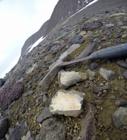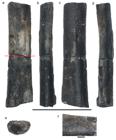Abstract
Fossil vertebrates from Antarctica are considerably rare, hampering our understanding of the evolutionary history of the biota from that continent. For several austral summers, the PALEOANTAR project has been carrying out fieldwork in the Antarctic Peninsula in search for fossils, particularly Cretaceous vertebrates. Among the specimens recovered so far are two bones referable to Pterosauria, more specifically to the Pterodacyloidea, the first volant reptiles from Antarctica to be fully described. MN 7800-V (part and counterpart) was recovered from a moraine at the Abernathy Flats (Santa Marta Formation, Lachman Crags Member, Santonian-Campanian) on James Ross Island. It is interpreted as the distal articulation of a first phalanx of the wing finger, representing an animal with an estimated wingspan between 3 and 4 m. The second specimen (MN 7801-V) comes from Vega Island (Snow Hill Island Formation, Maastrichtian) and is identified as a wing metacarpal IV of an animal with an estimated wingspan from 4 to 5 m. These occurrences show that pterodactyloids inhabited the Antarctic Peninsula at least during the Upper Cretaceous and demonstrate that large pterosaurs were widespread through all parts of the planet during that period.
Key words
Antarctica; Antarctic Peninsula; Pterosauria; PALEOANTAR; Cretaceous

 Thumbnail
Thumbnail
 MN 7801-V from Veja Island.
MN 7801-V from Veja Island.
 Thumbnail
Thumbnail
 Thumbnail
Thumbnail
 Thumbnail
Thumbnail
 Thumbnail
Thumbnail
 Thumbnail
Thumbnail
 Thumbnail
Thumbnail
 Thumbnail
Thumbnail







